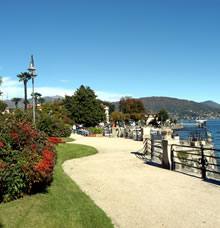
- CHIESE, SANTUARI, LUOGHI E PERCORSI SACRI
- VILLE E PALAZZI
Baveno
The old town of Baveno – whose historic nucleus has buildings dating back to the 10th century – is currently a well-known and fairly popular climatic. Its weather conditions, which are normally favourable and mild, have supported the development of flourishing international tourism.
The settlement of man in this area of the southern shore of the lake was presumably favoured by the opportunity to rather effortlessly extract an abundance of valuable pink and red granite from the surrounding mountains (especially from Mount Camoscio).
The church, baptistery and villas in Baveno
The map of Baveno ideally radiates from the Parish Church of SS. Gervaso e Protaso. It was built in the 11th century using stones made with the local granite. The gabled façade is embellished with hanging arches and has a single rounded portal in the lower section, on the sides of which two Roman memorial stones are walled up, which were found in the surrounding area. The ruins can still be admired of an ornamental fresco depicting two human figures enclosed by a polychrome frame. The square, Romanesque bell tower stands out in the village and immediately captures the visitor’s attention. Next to the church is the early Christian baptistery characterised by a peculiarity: from the outside it is square, however from the inside it is orthogonal. It was renovated during the Renaissance period.
Leaving the town centre, there are several 19th-century villas of aristocratic origin. These include Villa Fedora, where famous composer Umberto Giordano wrote the piece giving this building its name, and Villa Branca (previously Villa Clara and then Villa Maria) at the entrance to town; it’s white pinnacles in clear contrast with the red bare bricks are unmistakeable./p>
Feriolo
A hamlet of the Municipality of Baveno, the small town of Feriolo is known for its ancient origins as indicated by the castle ruins (still visible today) on the nearby headland. They are proof as to how this place was once of significant strategic importance and has changed over time, and is now of significant importance for communications. The roads irradiate from here leading inwards from Lake Orta and the Ossola Valley, as do those running alongside the lake to Verbania and the Canton Ticino.
The lakeshore flattens out after Feriolo due to the wide mouth of the Toce River, one of Lake Maggiore’s most important tributaries.














